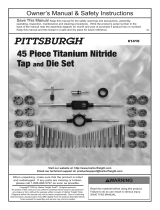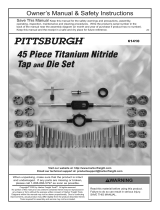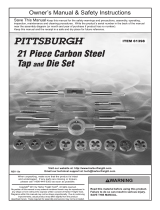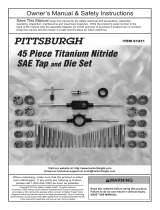
Page 3For technical questions, please call 1-888-866-5797.Item 62832
Operation Instructions
Read the ENTIRE IMPORTANT SAFETY INFORMATION section at the beginning of this document
including all text under subheadings therein before set up or use of this product.
Before using either taps or dies, test the material to determine that it
is not hardened by attempting to mark it with a file.
• If the material marks with a file, material should be cuttable.
• If the material will not mark with a file,
do not cut threads to avoid tool damage.
Tap Instructions
TAPS are used to cut (tapping) or clean (chase) internal threads into
a pre-drilled hole, such as in a nut or component part.
1. To cut an internal thread, first select
the tap of the desired size and have
lubricating or cutting oil ready for use.
2. The proper hole size is very important to
successfully cut good threads. An oversized
hole will result in shallow threads, and poor
holding power. An undersized hole may cause
the tap to wear prematurely or break. The correct
hole size is marked on the shank of each tap.
3. Insert the square end of the Tap into the
Tap Wrench, turn the threaded side of the
Tap Wrench to secure the Tap firmly.
4. Precisely align the tap with the direction of the
hole. THIS IS ESSENTIAL. The first cut will help
determine the accuracy of the entire finished thread.
5. Start turning the Tap clockwise, keeping the
Tap aligned with the hole. As the Tap turns, it
will bite into the metal and create threads.
6. After every 1/4 to 1/2 turn of progress, depending on
material hardness, rotate the Tap counterclockwise
an equal amount to prevent chips from building
up in the hole and breaking the tap.
7. Lubricate amply with cutting oil while tapping.
Proper lubrication will result in smoother threads,
and increased tool life. Continue tapping
until the Tap passes through the workpiece,
or the desired thread depth is reached.
8. Carefully thread the tap out backwards
and clean out any chips from the hole.
Die Instructions
DIES are used to cut (threading) or clean (chase) external threads, such as on a screw or threaded rod.
NOTE: It will be easier to start the Die correctly if
the end of the work material is slightly chamfered
with a grinder or file (not included).
1. Select the proper Die size for the rod to be
threaded. The Die can be no larger than the
rod stock, and should be .005″ to .010″ smaller.
Oversized rod stock may damage the die, and
will make turning it difficult. Slightly undersized
rod stock makes turning the die easier, and will
result in good threads for most applications.
2. Secure the workpiece in a vise or other fixture
(not included). Ensure that the workpiece will not
move or turn while it is being threaded. Note that
the workpiece may be damaged by the vise
during the threading process. When possible,
thread the workpiece before cutting it to the
final length to eliminate the damaged area.
3. Insert the Die into the Die Wrench.
Align the groove on the side of the Die with
the Screw on the Die Holder. Tighten the
screw using the included Screwdriver. Use
the Screw on side of the Die Wrench to secure
the Die firmly in place. See Figure A.
Screw
Die
Figure A
4. Place the chamfered side of the Die onto
the workpiece, being careful to precisely
align the Die perpendicular to the rod.
5. Begin turning the Die clockwise. The cutting
edges will begin to bite into the material, and
the Die will begin to thread itself onto the rod.
6. As you progress, apply lubrication, using a high-
quality cutting oil. As with the Tap, reverse
the Die to clear the shavings after every 1/4
to 1/2 turn of progress, depending on material
hardness. Continue this forward and back
process, using proper lubrication, until you
have cut the desired length of threads.
7. Then turn the Die counterclockwise
completely off the rod.








